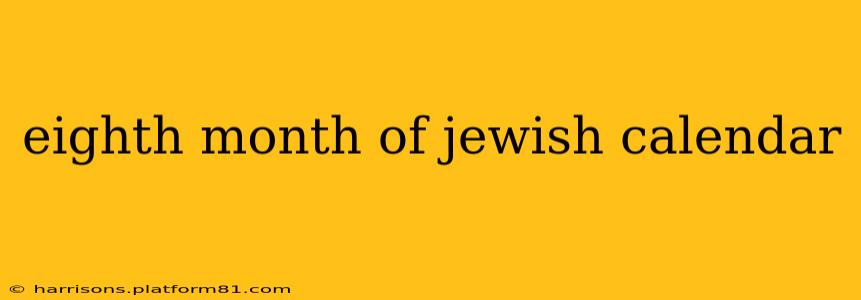The Jewish calendar, a lunisolar calendar, is rich in tradition and meaning. Each month holds significance, reflecting agricultural cycles, historical events, and spiritual observances. This exploration delves into Cheshvan, the eighth month of the Jewish calendar, often overlooked but nonetheless integral to the year's rhythm.
Cheshvan, also spelled Chesvan or Heshvan, is a unique month. Unlike many other months, it doesn't possess a fixed number of days; it can have either 29 or 30 days depending on the lunar cycle. This variability adds to its somewhat ambiguous nature, a month often described as lacking significant holidays or festivals. However, its very lack of fixed observances allows for a period of reflection and preparation for the upcoming holidays.
What is special about Cheshvan?
This is a common question, and the answer lies in its position within the liturgical year. Cheshvan acts as a bridge. It follows Sukkot, the joyous Festival of Tabernacles, and precedes Hanukkah, the Festival of Lights. This transitional period offers a space for quiet contemplation and a shift in focus from the harvest celebrations to the anticipation of the winter holidays. While not possessing its own significant holidays, its importance lies in its preparation for the next phase of the Jewish calendar.
What holidays are in Cheshvan?
While Cheshvan doesn't feature major fixed holidays like Rosh Hashanah or Yom Kippur, its variable length can sometimes impact the scheduling of other celebrations. The exact dates of holidays vary from year to year, depending on the lunar cycle. There are no major fixed holidays celebrated solely within Cheshvan.
How many days are in Cheshvan?
As mentioned, Cheshvan has either 29 or 30 days, depending on the lunar cycle. This variability is a defining characteristic of this month and makes it unique in the Jewish calendar.
What are the customs and traditions during Cheshvan?
Given its lack of significant fixed holidays, Cheshvan presents an opportunity for personal reflection and spiritual growth. Many individuals use this time for introspection, studying Torah, engaging in acts of tzedakah (charity), and preparing for the upcoming winter holidays. The quietude of the month allows for a deeper connection with spirituality and a mindful preparation for the intensified observance of Hanukkah and the upcoming winter months.
Is Cheshvan a good time for prayer?
Any time is a good time for prayer, and Cheshvan is no exception. Its relatively quiet nature, free from major holidays, can actually create a more focused environment for personal prayer and spiritual engagement. Many find this a time for increased introspection and deeper connection with their faith.
How is Cheshvan different from other months?
Cheshvan's primary difference lies in its variable length and the lack of significant fixed holidays. Unlike months like Tishrei (which contains Rosh Hashanah and Yom Kippur) or Kislev (which includes Hanukkah), Cheshvan serves as a transition between significant festival periods. This transitional quality makes it a unique and often overlooked month in the Jewish calendar.
In conclusion, while Cheshvan might not boast the fanfare of other Jewish months, its significance is undeniable. It's a period of quiet reflection, a bridge between major celebrations, and a time for spiritual preparation. Understanding its nuanced role within the Jewish calendar provides a more complete appreciation for the cyclical nature of Jewish life and the rich tapestry of its traditions.
